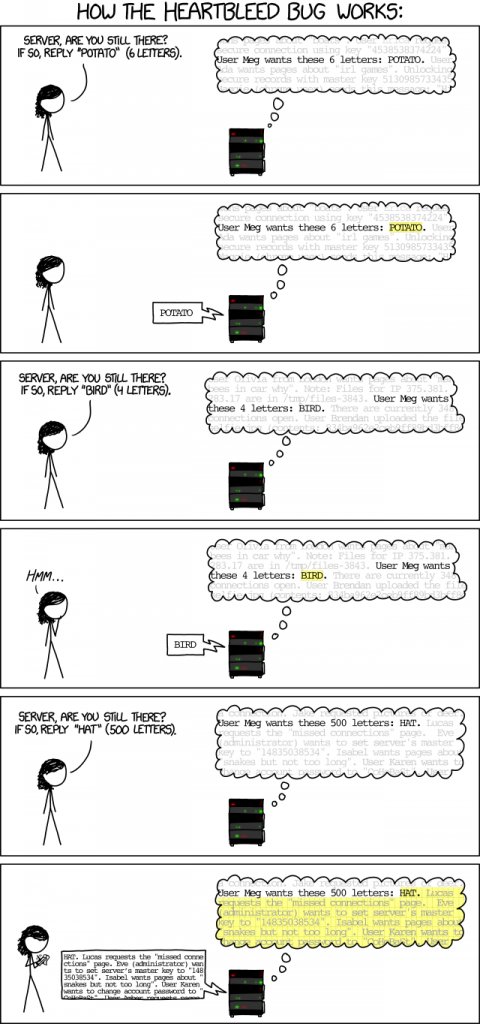
The Heartbleed vulnerability has been all over the news this past week. As usual, the media sometimes twists the facts, sometimes intentionally, other times inadvertently. For example, I’ve heard Heartbleed being called a virus, or being framed as something that was deliberately created to be malicious. Also, from reading people’s comments on the online news articles and blog posts, it seems that many people don’t really understand what Heartbleed is or does. From my point of view as a software developer, I would like to provide some information and resources that I believe are true and report the facts (but as I’m not an expert in the field of encryption/security, you may also want to take these with a grain of salt).
Heartbleed explained
What Heartbleed is simply a software bug. Sure, there are bugs in nearly all, if not all, software out there (obviously we developers try not to introduce bugs, but we humans are unfortunately imperfect 🙁 ), but what makes this particular bug newsworthy?
- This particular bug is a vulnerability, which allows a malicious attacker to gain information that should not be accessible.
- The bug is in a library (called OpenSSL) that is used in a number of programs that in turn are run on a large number of computers worldwide.
- The vulnerability has been out in the wild for two years.
- There’s no trace left behind by a malicious attacker exploiting this vulnerability.
I came across this XKCD comic last night. I think it’s a pretty simple way to understand what the Heartbleed vulnerability allows a malicious attacker to do.

The comic illustrates the case where the victim is the “server” and the malicious attacker is the “client.” This is the case that most people are concerned with, as it is likely that servers running the exploitable software are easier to find and will probably have more “interesting” data in the memory. The data could potentially be usernames and passwords, credit card information, or encryption keys, but on the other hand it could also be just bogus data that happened to also be in memory. The data that the attacker could gain really depends on what happens to be in adjacent memory at that time.
However, the vulnerability exists both ways (if the software on the “client” is using a vulnerable version of OpenSSL). You could be owning a device or running a program on your computer that might allow a “server”, which has been maliciously programmed, to read memory off of your device using the same exploit. For example, Android 4.1.1 devices are susceptible to Heartbleed.
Although web servers are the most common targets being mentioned, there are other services that could possibly be affected by Heartbleed including FTP servers and mail servers.
If you are interested in the nitty gritty details behind how the exploit works, CloudFlare has an article on the low-level details (just disregard the fact that they say that private keys aren’t accessible because they were disproved on that point). For higher level information on Heartbleed, the heartbleed.com site has very clear information and a nice FAQ. Troy Hunt also has an informative FAQ about Heartbleed.
What to do about it
For end users
Since there is no trace when an attacker exploits Heartbleed compounded by the fact that Heartbleed has been vulnerable for over two years, it’s not possible to determine exactly what data has been compromised. In addition, if encryption keys were gleaned from Heartbleed, it is possible for even more data to be compromised by decrypting historic logs (if they exist in the hands of the attacker).
So for end users, the precautionary recommendation is to change your passwords after the services that were affected have been patched. Mashable has a running list of the status of popular web services that you can use to determine whether to change your password. In case you use a service that isn’t listed there, you can check it yourself on Filippo Valsorda’s test site. However, keep in mind that not only web services are affected. There are recommendations not to login to services that are still known to be vulnerable because when you login there is a chance that your credentials will be placed in memory, which is susceptible to be read. In addition, ensure that all the software and operating systems you are running are up to date.
For system administrators, developers and service providers
Obviously, ensuring that OpenSSL is up to date or patched is top priority. Troy Hunt provides some additional advice in his blog post.
Heartbleed and the goto fail and GnuTLS bugs
Heartbleed isn’t related to the Apple goto fail or the GnuTLS bug we’ve seen in the past couple months. The goto fail and GnuTLS bugs are susceptible to man-in-the-middle attacks where a malicious intruder can pretend to be the trusted service you’re communicating with and intercept messages between you and the service. Heartbleed on the other hand allows attackers to read parts of the computer’s memory that they should not have access to.
OpenSSL and open source projects
OpenSSL is an open-source project with eleven volunteer developers, maintaining one of if not the most used SSL/TLS libraries, probably on their own time. I think they should be respected for taking on the heavy responsibilities of this project.
Open-source projects allow external developers to read the source code and even submit improvements and contributions. Depending on the project, there are different procedures to getting contributions accepted, usually including a code review process where the core maintainers ensure that the contributions work as intended and meet the standards of the project (kind of like how a newspaper editor goes over the articles of his writers before they get published). Since humans aren’t 100% perfect, bugs and mistakes unfortunately happen, as much as we try not to allow them.
While it is possible to order security audits of software, for open-source projects that usually don’t generate any profit, it is difficult to come up with the money. I remember when we got a security audit for MyBB, it was in the order of thousands of dollars.
Conclusion
There is a lot of information about the Heartbleed vulnerability on the news and media, and from reading the comments on many of the blog posts and news articles I have read, many people don’t really understand what Heartbleed is and its implications. I hope that this article sheds a little bit of light on that, and provides more resources for those who want to dig a little deeper in understanding it.

